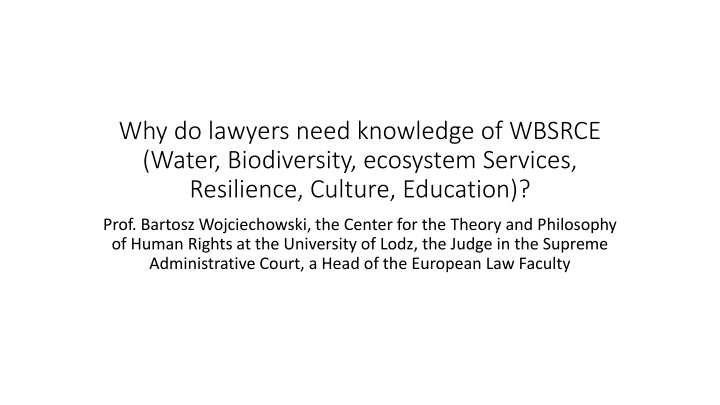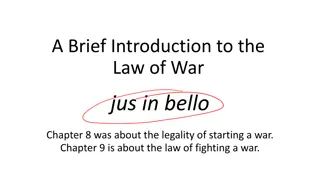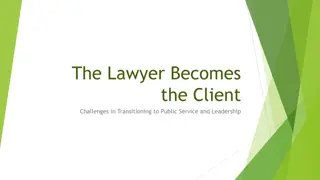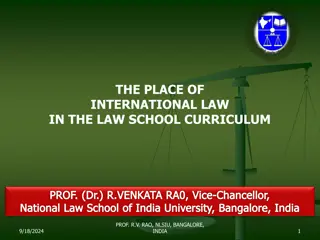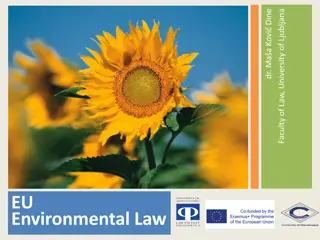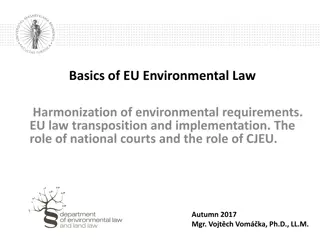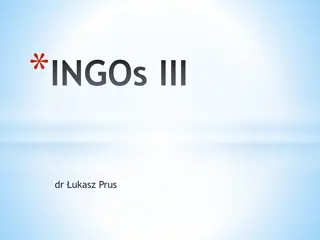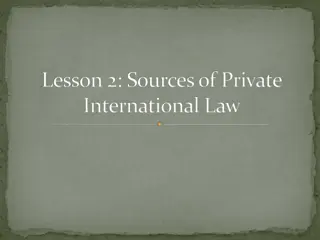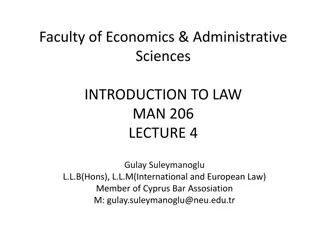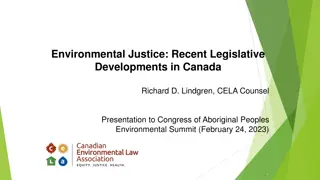The Changing Role of Lawyers in Environmental Law: Embracing WBSRCE Principles
In today's evolving legal landscape, lawyers must adapt to new paradigms like WBSRCE (Water, Biodiversity, Ecosystem Services, Resilience, Culture, Education) to address the complex interplay between human rights, environmental law, and the recognition of legal personhood for natural entities. By understanding the significance of biodiversity, representing nature's interests, and advocating for environmental protection, lawyers can navigate towards a more holistic and sustainable approach to law.
Download Presentation

Please find below an Image/Link to download the presentation.
The content on the website is provided AS IS for your information and personal use only. It may not be sold, licensed, or shared on other websites without obtaining consent from the author.If you encounter any issues during the download, it is possible that the publisher has removed the file from their server.
You are allowed to download the files provided on this website for personal or commercial use, subject to the condition that they are used lawfully. All files are the property of their respective owners.
The content on the website is provided AS IS for your information and personal use only. It may not be sold, licensed, or shared on other websites without obtaining consent from the author.
E N D
Presentation Transcript
Why do lawyers need knowledge of WBSRCE (Water, Biodiversity, ecosystem Services, Resilience, Culture, Education)? Prof. Bartosz Wojciechowski, the Center for the Theory and Philosophy of Human Rights at the University of Lodz, the Judge in the Supreme Administrative Court, a Head of the European Law Faculty
A new paradigm for understanding law In today s world, paradigms and ways of perceiving various social phenomena are changing, including those pertaining to the relations between human beings and nature. Adapting to this changing reality is by no means easy. Lawyers, in particular, find it difficult to let go of existing meanings and to change their ways of understanding and interpreting certain institutions. This situation is encouraged by the positivist vision of law that still prevails in legal thinking, which justifies strict adherence to the letter of the law. However, we should be moving in the other direction: in order to escape from the vision of the state as a mythical Leviathan, we should view the law as an interpretative fact, the correct interpretation of which requires referring to economic, cultural, social or ecological arguments.
Whanganui Whanganui
A New Zealand river is treated like a human being A New Zealand river is treated like a human being This new approach is noticeable in the case of the Whanganui River, a waterway revered by the Maori as the Te Awa Tupua, which has been granted legal personhood. The river will be treated as a minor before the courts; it is represented by two indigenous New Zealanders and has representation in parliament. The idea of recognising elements of nature as having legal personality has been around for many years, as part of proposals for a new approach to ecology. However, recent years have seen the introduction of concrete solutions in this regard. In various parts of the world, there are attempts to recognize rivers (as well as other elements of the natural environment) as separate legal entities. As yet, this trend is not universal, since only a few examples can be identified in the existing legislation. From a typically legal perspective, the clear arguments for extending the concept of legal entity to environmental elements deserve attention. Nature is in need of protection and, in order to receive it, it should obtain legal personality and its own independent rights, so that it can sue entities that harm it and receive appropriate compensation.
Legal definition Biodiversity is of vital importance to all living nature. It can be defined as the diversity of living forms, with all their variability at the microscopic and macroscopic levels. It is the sum of all genes, species, habitats and natural processes that constitute the essence of the Earth ss existence (Biodiversity and the Law, ed. W.J. Snake III, Washington 2009, p. XIX). Currently, biodiversity is one of the most important concepts in contemporary law focused on the protection of nature and the environment. The level of biodiversity is a crucial factor for achieving sustainable development objectives on global, regional and local scales, as well as for the implementation of the principle of justice between generations.
This concept was legally defined by the Convention on Biodiversity, which was open for signature at Rio de Janeiro on 5 June 1992 (currently the Convention has 196 signatories, including the European Union, which adopted the Convention by decision of the Council of the EEC of 25 October 1993). (OJ L 309, 13.12.1993). According to its provisions, biodiversity means the variability among living organisms from all sources including, inter alia, terrestrial, marine and other aquatic ecosystems and the ecological complexes of which they are part: this includes diversity within species, between species and of ecosystems.
One of the fundamental principles of sustainable development is maintaining the dynamic balance of ecosystems. This is of critical importance because if an ecosystem is subjected to overexploitation and its biotic structures are degraded, it reaches a point where its bioproductivity becomes insufficient, or even impossible. Since ecosystem functioning, its biodiversity and bioproductivity are the result of the long evolution of biogeochemical processes, it is crucial to have a thorough understanding of these matters. This is essential knowledge for achieving sustainable development in the face of human population growth and climate change. Equally importantly, it is also basic knowledge for controlling ecological processes in order to enhance the resilience and robustness of the natural environment. And lawyers have rather limited knowledge of these matters to say the least!
Professor Maciej Zalewski and Professor Edyta Kiedrzyska, as well as other members of their team from the European Regional Centre for Ecohydrology of the Polish Academy of Sciences, aptly point out that anthropogenic changes caused by water and land management result in accelerated outflow of water from catchments through river regulation and bank levelling (in the article The enhancement of valley water retentiveness in climate change conditions).
The ask Reservoir project An example of the application of the ecohydrological approach in combination with hydrological engineering is the ask Reservoir, which is under construction in the Grabia River basin. The ask Reservoir is designed to increase environmental potential in line with the strategy of WBSRCE (Water, Biodiversity, ecosystem Services, Resilience, Culture, Education). The area originally intended for the reservoir is a section of an invaluable meandering lowland river. As the primary function of the planned reservoir is recreation, the key idea was to maintain the natural character of the river while guaranteeing good water quality in the reservoir. To achieve this, a reservoir structure was proposed on a floodplain beside the river. In addition, a water quality analysis system was designed to automatically shut off inflow to the reservoir during low periods, when the minimum acceptable flow would be difficult to meet, and during periods of poor water quality, which would result in the accumulation of nutrients, eutrophication, and the occurrence of toxic algae blooms. In addition, in the reservoir inlet a sequential sedimentation-biofiltration system will be constructed to reduce suspended solids and nutrients, and its biological part (macrophyte communities) will be a refuge for biodiversity.
Positivistic thinking So why is there resistance from officials (public administration bodies) and lawyers? The answer seems simple: lack of adequate knowledge and fear of innovative approaches which challenge existing solutions.
Conclusion The right to water should be regarded as a subjective right of nature, in other words something more than a third-generation human right. It is a right belonging to all living organisms and nature as a whole, including the inanimate part. The situation in this field is dynamic, so it should be expected that the subjective approach to nature will increase in popularity, especially as the problem of environmental protection becomes more pressing and the ineffectiveness of the mechanisms used to date becomes more evident.
Recognition of natures inherent rights as a subject, and their acceptance and incorporation into the legal system, requires not only changes in the law, but also a paradigm shift in thinking about the legal system: one which places human beings at the centre, but also takes into account the needs of other living beings and nature as a whole. However, the attempts to introduce this construction have been made in response to the inefficiency of the existing environmental protection system, the evident need to the search for more effective instruments, and the awareness of the need to develop an alternative worldview that can replace the prevailing one. Nature s subjectivity is recognized in many religious systems; the approach to nature as an equal partner with its own rights is not alien to many cultures, but it is manifested in their customs and beliefs rather than in their legal systems. The legal system known to the West, which largely dominates the world, recognizes forests, mountains and rivers as objects of property, but does not recognize them as subjects of law.
